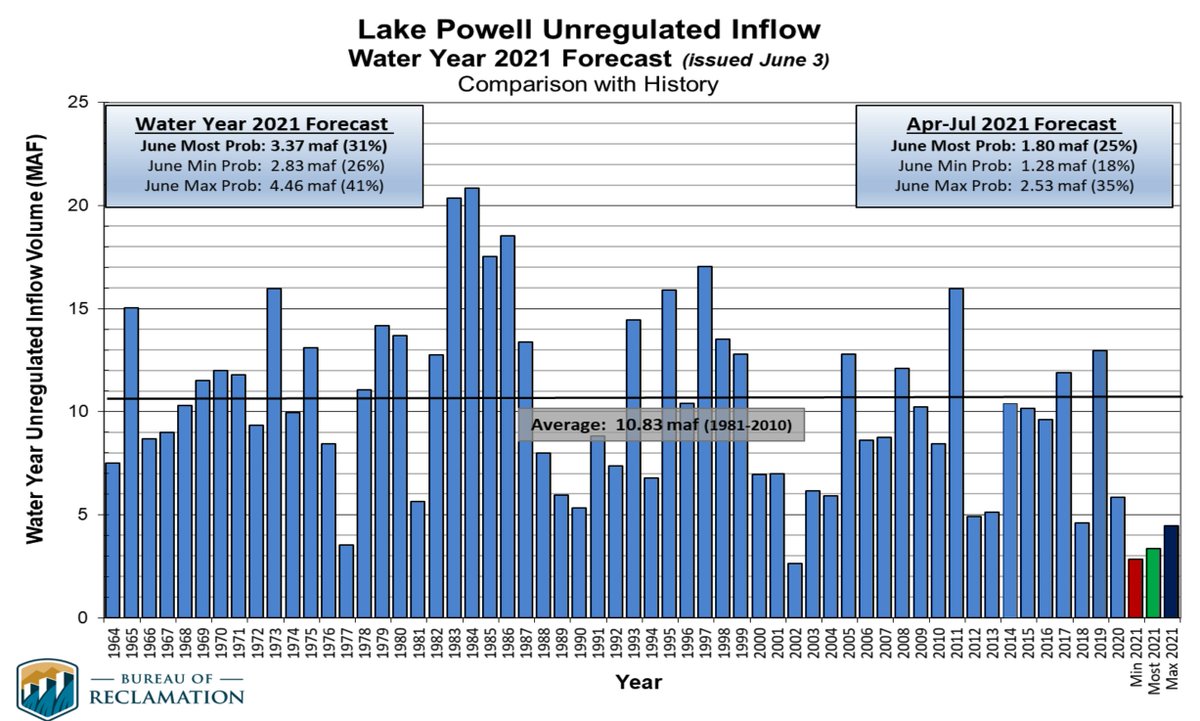
2. Reclamation’s ‘unregulated inflows’ into Lake Powell show that 2021 will be the 2nd worst year after only 2002 going back to 1964. 2021 will be the RED bar most likely. This is a really grim year for runoff. 

3. 2021 Inflow will be only ~3 maf, compared to the 1981-2010 average of 10.3 maf or the 2000-2021 average of 8.3 maf (20% less than 1981-2010 average).
(maf = million acrefeet)
(maf = million acrefeet)
4. Considering that Powell will release / evap ~ 8.5 maf, the lake will lose ~ 5 maf this year or ~55 feet of elevation.
5. April 2021 snowpack above Powell peaked at ~85% of normal but will generate about 25% of normal river flow. This comes on top of April 2020 snowpack of 100% of normal that generated about 50% of normal flow.
6. Declining runoff efficiency has been noted in multiple peer-reviewed studies. For a recent overview of all recent #climatechange studies on the #coriver see this watercenter.colostate.edu/wp-content/upl… Written with @GreatLakesPeck. 

7. Here's what's going to happen to the nation's 2 largest reservoirs because of this measly inflow: 

8. Note that combined contents will drop below 30% by late next year.
9. Here's that decline for all years back to 1935 when Mead first filled. These two reservoirs will hold less water than Mead did alone in many years before 1964 when Powell was built. 

10. By next April Powell will hit 5.4 maf, ~185 feet below full. See Red dots. This will be the lowest since its initial fill in 1964. Since 1999, Powell will have lost ~18 maf, 75% of its contents. 

11. At 5.4 maf Powell could be low enough to lose the ability to generate power. (We’re uncertain about how penstocks operate when lake gets low -- water in penstocks can not be aerated or turbine damage will occur.)
12. Loss of power while not calamitous is concerning. Power revenues fund environmental compliance and other important items in the basin.
13. As part of the 2019 agreement, the UB can release flows from reservoirs upstream of Powell to prop it up. But there is only about 5 maf for that all together. It is a one-shot deal.
14. We’ll have to wait on next winter to understand what happens after April of 2022. But 5.4 maf is very little water in a 25 maf reservoir.
15. So what about Lake Mead, the nation’s largest reservoir?
16. Reclamation’s current forecasts show January 1, 2022 elevation at 1065’ feet (8.8 maf) , well below the 1075’ needed to avoid a ‘Tier 1 Shortage’. 

17. Projections for Mead show it dropping through 2022, ending up near 1050’ (7.6 maf) on January 1, 2023. 1050’ is another critical trigger point. 

18. If it ends up below 1050’ on Jan 1 (as projected in August 2022), that will lead to a Tier 2 Shortage (total cutbacks of 721 kaf). Otherwise, Mead will face a 2nd year of Tier 1 shortages. Either way, this is not good.
19. I will do another thread with analysis soon. Suffice it to say for now that none of this is good news.
Please unroll @threadreaderapp
• • •
Missing some Tweet in this thread? You can try to
force a refresh



